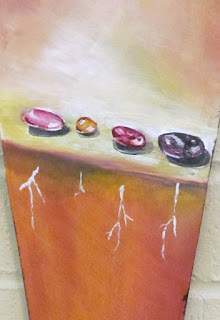I have great faith in a seed. Convince me that you have a seed there, and I am prepared to expect wonders. -Henry David Thoreau
Sunita and I step out of the hired van after a bumpy five-hour ride,
hitching our backpacks up on our shoulders. From the dirt road, we take a
small path that leads down a hill to a series of brilliant green rice
paddies. We walk carefully along the narrow strip of raised dirt that
separates the shallow ponds, eyes set on the tiny hut just beyond them.
In
front of the house is a typical south Indian vegetable garden - a
tangle of vines, huge bushes and bamboo trellises surrounded by a fence
of pointed sticks woven together to deter wandering cows and water
buffalo. The woman of the house greets us; we remove our shoes and I
duck to enter the dark, smokey room. When my eyes adjust from the bright
subtropical sunlight, I spot our prize: The dried gourd hanging above
the fireplace.
India's traditional food culture is on the brink
of extinction. What was once a self-sufficient subcontinent, which gave
the world spices and tea as well as now-widespread vegetables like
eggplant, now relies on foreign food imports, thanks to the complicated
forces of globalization.
As in America, India's small farmers are a
dying breed, and few propagate heritage crops. Those who do are not
aware of the gold mine they're sitting on: Hundreds of varieties of rare
grains, vegetables and legumes that were passed through generations and
perfectly suited for the unique climates of this diverse region.
Our
hostess takes down the hollow gourd and removes the cork that seals its
contents from the year-round humidity. She shakes out a few seeds into
her hand. To me, they don't look like much more than dried-up plant
parts, but to her, they are life itself.
I began to understand the
importance of seeds as an intern with Sunita's tiny NGO, Vanastree, in
the fall of 2008, my junior year of college. Trekking from the coasts to
the jungles to the deserts with her, taking photos of vegetables,
collecting seeds for Vanastree's seed bank, and talking with the women
who propagated them year after year, I returned home knowing that I
would never take a bite of food for granted again.
In the US, our
food supply is equally precarious, although we may not realize it yet.
Around 20 food crops make up the vast majority of the standard American
diet. Heirloom varieties exist, but seeds have a life span just like us -
usually from one to five years - and an entire line of tomato or
lettuce can be lost if not planted and grown and the seed saved again.
This might not sound like a big deal now, but those 20 crops we're
relying on today are only the best crops because they function well in
the current climate. In 100 years, it will be too late resurrect the
varieties that produce well in, say, drought conditions, or temperatures
an average of ten degrees warmer than we see today.
Seeds
are miracles, the eruption of life from a dormant husk, which will
eventually flower and make new seeds to start the cycle over again.
Ideas are like seeds, starting out as something small and unassuming and
then, under the right conditions, becoming a crazy tangle of life with
an ever-changing form.
Hannah and I received an idea-seed during a
nervous presentation to Hummingbird Wholesale, a local food business
that eventually agreed to sponsor Food Cycles. As we discussed the
potential and possibilities of bicycling cross-country for local food
with the creative minds behind one of our area's pioneering businesses
in bringing local foods to the masses, someone mentioned the possibility
of us distributing seeds as we traveled.
I wrote it down. I
looked at my notebook the next day. The more I thought about it, the
more I knew there was no way I could not pursue this act. We're taking
this bicycle trip in the winter and spring - the perfect time to plant
seeds, especially once we reach the southern climes. This could be the
focus, the actionable element of our journey. Rather than just do the
chores we're asked to do when we volunteer at farms or stay with
friends, we can offer something tangible to leave behind. Going into an
elementary school, we can not just talk about the benefits of teaching
kids about where food comes from, we can march out into the playground
with them and poke a few sunflower seeds into a forgotten patch of
earth. With seeds, we have the power to actually leave a trail of green
as we travel.
I emailed a local seed grower, Aline from
Green Journey Seeds, and she offered 100 packages of cilantro. Farmer
friends are culling their supplies, and I put what I found in my fall
garden cleanup into some paper envelopes (sadly, my supply of
hollowed-out gourds is slim).
If you would like to put your faith
in a seed, as Thoreau would ask, email us! We're planning to bring
herbs, lettuces, greens and other lightweight seeds that are easy for
beginning farmers and gardeners to grow. We will trade them for more
seeds or give them away when we see a need. We'll be a mobile seed bank.
We'll never go hungry.



Food is main factor for every person's health. I need the hybrid & non hybrid of seeds with different features. Well! You can get the no. of heirloom seeds with various advantages then have visits at: www.heirloomseedbanks.com
ReplyDelete